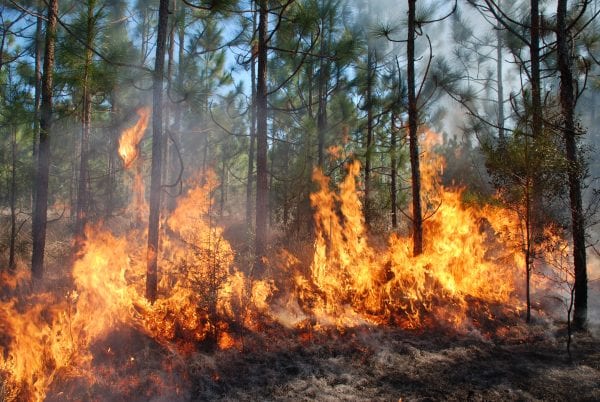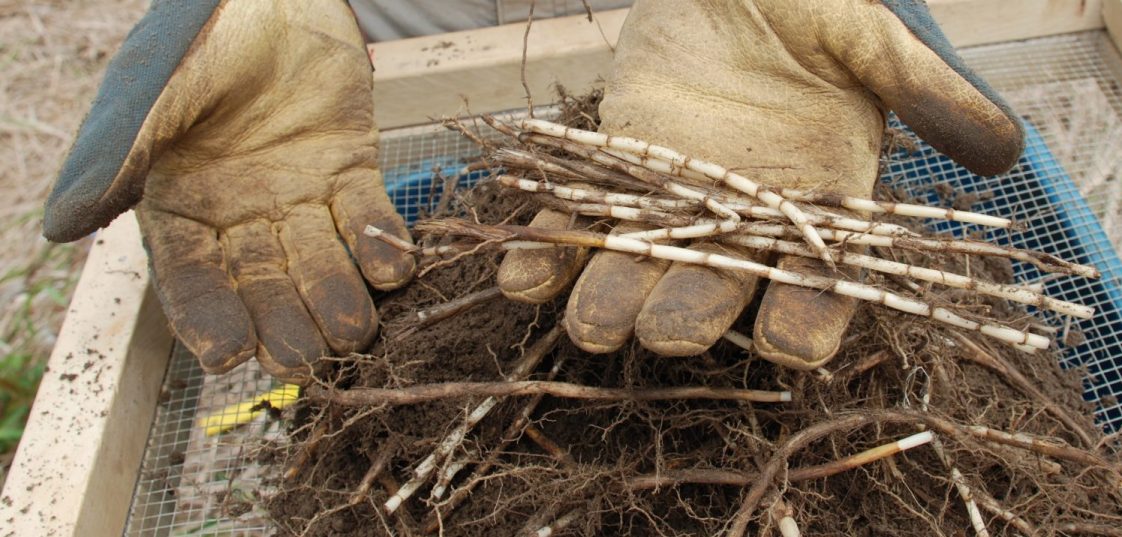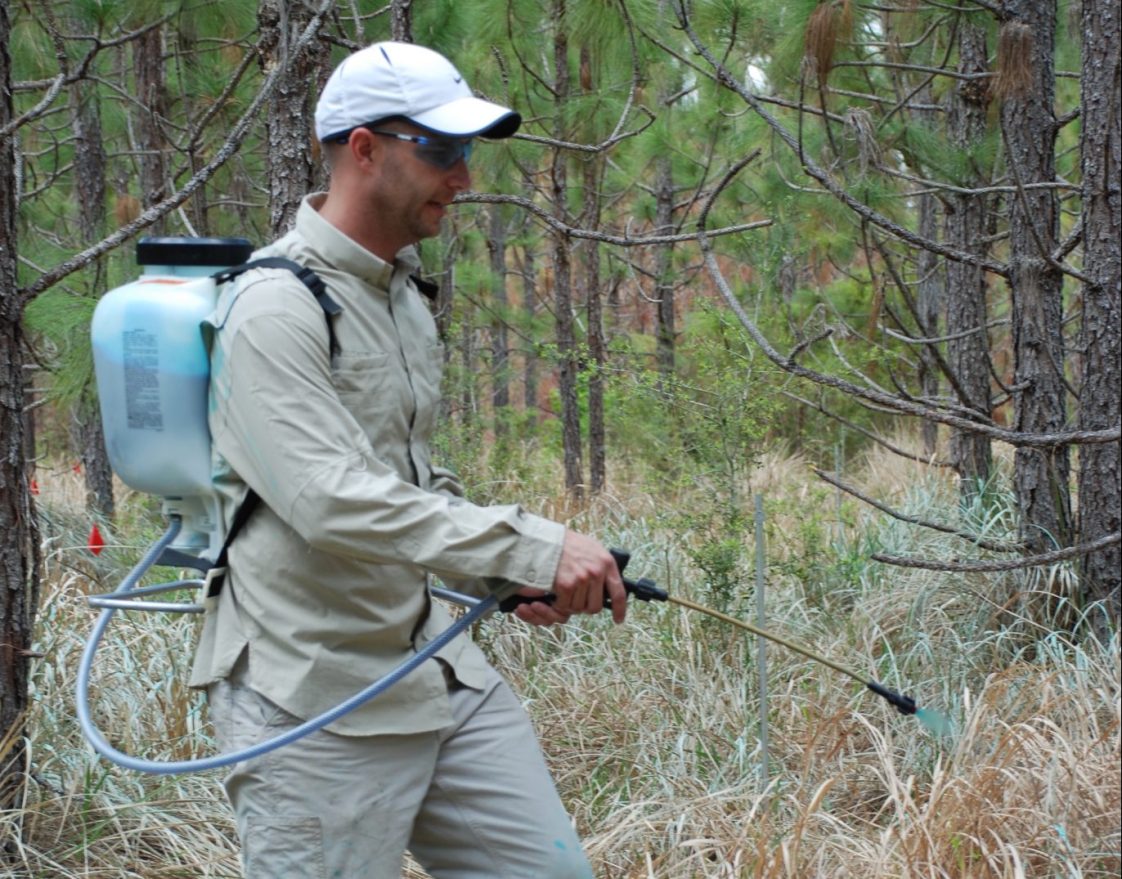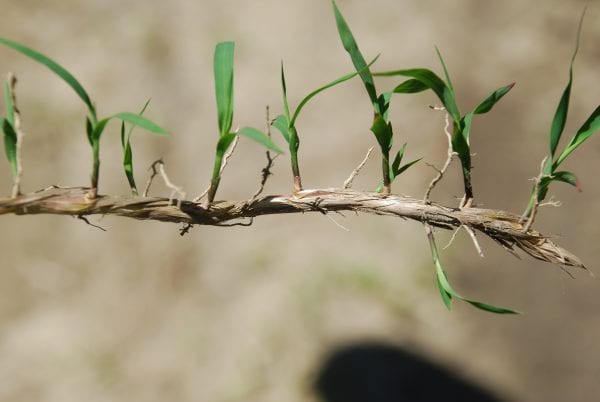Forestry & Wildlife

Cogongrass (Imperata cylindrica) is one of the greatest invasive plant threats in Alabama and the southeastern United States. Although it has been here for more than a century, the problem has dramatically increased in the past few decades.
Many land managers actively and aggressively manage cogongrass. Auburn University researchers have worked on solutions for cogongrass for many years. This publication provides a summary of that research and is in the form of answers to the most common questions regarding cogongrass management.
Q: Can I hand pull cogongrass?
Cogongrass has sharp leaf edges and razor-sharp sprouts at ground level, making hand pulling quite hazardous. Furthermore, it is extremely difficult to pull cogongrass without leaving behind rhizomes (underground stems), making this approach largely ineffective, even for very small patches.
Q: Will tillage alone control cogongrass?
In areas that can be accessed with machinery, repeated tillage that breaks up the entire rhizome layer will eventually exhaust the energy reserves of cogongrass rhizomes. Tillage fragments the rhizome network, increasing new shoot emergence. When repeated after new shoot emergence, tillage will further disrupt growth and decrease stored energy reserves. This approach of repeated tillage can work well over time if repeated frequently. If tillage is not repeated, the cogongrass patch may end up thicker than it was to start with and can scatter rhizomes into areas not previously infested. Shallow or infrequent tillage, such as disking, field cultivating, or chisel plowing, will generally not control cogongrass. Research has shown rotary tillers powered by tractor PTO are the most effective when used repeatedly to prevent new emergence. Clean tillage equipment carefully to avoid spreading rhizomes.
 Q: Will prescribed fire control cogongrass?
Q: Will prescribed fire control cogongrass?
No. Prescribed fire at any time promotes cogongrass to the detriment of almost all other species. Dense cogongrass can burn hot enough to kill many fire-tolerant species, even young loblolly and longleaf pine. Burning dense patches of cogongrass when trees are at risk is not recommended. Cogongrass can also be spread by fire plows that can drag rhizome pieces to uninfested areas.
Q: Will grazing control cogongrass?
Cogongrass was tested as a potential forage crop in Mississippi and Florida more than 80 years ago and was virtually useless. Livestock will graze very young cogongrass shoots, but they tend to avoid it as it matures. Mature cogongrass foliage is high in silica and low in forage quality. Some cattle producers have used mowing to stimulate new growth for cattle grazing, but this is not an effective control strategy.
Q: What is the best herbicide to treat cogongrass?
Two herbicides, glyphosate and imazapyr, are most effective for cogongrass management. However, they are generally situation specific and require multiple treatments for complete control. Glyphosate is the safest option when treating cogongrass around desirable trees, shrubs, or other vegetation but is less effective than imazapyr. Imazapyr is more effective than glyphosate but cannot be used near most desirable vegetation, unless severe injury or death of that vegetation can be tolerated. Some pines, including loblolly pine, are tolerant of imazapyr. Longleaf pine, however, is not tolerant of rates of imazapyr needed to control cogongrass. Since imazapyr is absorbed by plant roots in addition to foliage and root locations cannot be seen, unintended consequences can result.
Q: Do any other herbicides provide effective cogongrass control?
Glufosinate (Finale, Cheetah, Interline) will provide a rapid brownout of the foliage. However, it does not translocate into the rhizomes and does not provide long-term control. Aminocyclopyrachlor combined with reduced rates of imazapyr has been used in noncrop areas and rights-of-way to suppress cogongrass in an attempt to reduce injury to desirable sods. However, our data indicates it is not effective as a stand-alone treatment for long-term control.
Q: What rate of these herbicides should I use?
 For any herbicide, use rates should be in accordance with label rates for the specific product you select. For glyphosate formulations that contain 41 percent active ingredient (4.0 lb./gal.), a 4 to 7 percent solution is recommended for spot treatments, and broadcast treatment rates should generally be between 3 and 5 quarts per acre. For glyphosate formulations that contain 54 percent active ingredient (5.4 lb./gal.), a 3.5 to 6 percent solution is recommended for spot treatments, and broadcast treatment rates should generally be at 7 pt per acre. For imazapyr formulations that contain 27.7 percent active ingredient (2 lb./gal.), a 2 percent solution is recommended for spot treatments, and broadcast treatment rates should generally be between 48 and 64 fluid ounces per acre. For imazapyr formulations that contain 53.1 percent active ingredient (4 lb./gal.), a 1 percent solution is recommended for spot treatments, and broadcast treatment rates should generally be between 24 and 32 fluid ounces per acre. When using herbicides, always read and follow the label.
For any herbicide, use rates should be in accordance with label rates for the specific product you select. For glyphosate formulations that contain 41 percent active ingredient (4.0 lb./gal.), a 4 to 7 percent solution is recommended for spot treatments, and broadcast treatment rates should generally be between 3 and 5 quarts per acre. For glyphosate formulations that contain 54 percent active ingredient (5.4 lb./gal.), a 3.5 to 6 percent solution is recommended for spot treatments, and broadcast treatment rates should generally be at 7 pt per acre. For imazapyr formulations that contain 27.7 percent active ingredient (2 lb./gal.), a 2 percent solution is recommended for spot treatments, and broadcast treatment rates should generally be between 48 and 64 fluid ounces per acre. For imazapyr formulations that contain 53.1 percent active ingredient (4 lb./gal.), a 1 percent solution is recommended for spot treatments, and broadcast treatment rates should generally be between 24 and 32 fluid ounces per acre. When using herbicides, always read and follow the label.
Q: Should I tank mix glyphosate and imazapyr?
There is no antagonism between glyphosate and imazapyr; they can be tank mixed. There may be some benefit to mixing the two herbicides if lower imazapyr rates are used. However, at the rates recommended above, research has not shown a control benefit in mixing the two herbicides. Tank-mixing herbicides such as these with different modes of action may be useful to prevent herbicide resistance. Mixing glyphosate with imazapyr does increase the speed of visual symptoms on treated cogongrass foliage compared to using imazapyr alone, as symptoms from imazapyr treatments can take as long as 30 days to become visible.
Q: What is the best herbicide application timing?
A single application of either glyphosate or imazapyr will rarely, if ever, completely eliminate the entire rhizome layer at any timing. However, the optimal treatment window for both herbicides is late summer through early fall. If spraying in the fall, it is important to spray early enough to give the treatment time to work (approximately 4 to 6 weeks) before a killing frost.
 Q: Can I treat in the early spring to prevent cogongrass flowering and seed production?
Q: Can I treat in the early spring to prevent cogongrass flowering and seed production?
Early spring treatment of the first green cogongrass shoots generally provides inconsistent reduction of flowering. However, fall treatment has worked very well to prevent flowering the following spring.
Q: Should I add surfactant to the tank?
For glyphosate, some products already contain surfactant and do not need extra. Add a nonionic surfactant at 0.25 to 0.5 percent v/v, if the label recommends it. If water hardness is an issue, adding ammonium sulfate to the spray tank is recommended when using glyphosate. For imazapyr, add a nonionic surfactant at 0.25 percent v/v or methylated seed oil at 1 percent v/v, depending on the herbicide formulation used.
Q: Should I add a dye or spray indicator?
A blue spray indicator is useful when spot spraying small cogongrass patches and is generally easier to see on the treated foliage than other colors, such as red. Spray indicators are easy to work with, water soluble, and do not stain like some true dyes.
Q: Should I mow or burn to remove the thatch layer before treatment?
For summer or fall treatments, the answer is no. For spring treatments, removing the old growth may stimulate new cogongrass growth and result in more leaf area at the time of treatment. However, as previously discussed, burning cogongrass at any time may injure or kill many trees. Mowing or burning in the winter may stimulate flowering in the spring. In addition, mowing cogongrass may result in a thatch layer that prevents the deposition of spray solution onto cogongrass foliage.
Q: How much regrowth do I need to spray after mowing or burning?
Allow at least 12 to 18 inches of regrowth before treating. If you treat with less regrowth, control may be poor. It is also fine to allow more than 18 inches of regrowth.
 Q: Should I spray beyond the edge of the patch?
Q: Should I spray beyond the edge of the patch?
Cogongrass spreads laterally by creeping rhizomes. You can often find a few small shoots creeping beyond the patch edge into numerous vegetation types. Some applicators have reported the formation of cogongrass halos (also called doughnuts) around patches in the growing season after treatment. This has prompted some applicators to spray a band about 10 feet wide beyond the patch edge. This is not recommended if you are using glyphosate because it has no soil activity. This is a useful option if you are using imazapyr because it may provide several months of soil activity. Quickly digging out beyond the patch edge will help you determine the prevalence of rhizomes beyond the patch edge.
Q: Can I treat cogongrass growing along water?
Yes, but only if you use a formulation of glyphosate or imazapyr labeled for use in aquatic sites, and always follow the label directions. DO NOT use any glyphosate product not labeled for aquatic use as it contains a surfactant that is toxic to aquatic organisms.
Q: How many times will I have to spray to completely eliminate all the rhizomes?
Research at Auburn has shown that imazapyr applied once per year for 2 or 3 years can eliminate the entire rhizome layer. Glyphosate applied twice per year in the late spring and fall for 2 or 3 years can also completely eliminate the rhizome layer. Significant differences have also been observed between cogongrass patches in the time it takes to eliminate the rhizome layer completely. Many land managers have noted this. The size of the cogongrass patch, the density of rhizomes, and other site conditions may impact treatment success.
Q: Are there any cost-share programs available to help with cogongrass treatment?
The National Resource Conservation Service (NRCS) has offered, at times, assistance for cogongrass treatment through the Environmental Quality Incentive Program (EQIP) or other programs, so check with your local office. The Alabama Forestry Commission occasionally has funding to assist with cogongrass control.
 Revised by Nancy Loewenstein, Extension Specialist, Forestry and Wildlife Sciences, Auburn University. Originally written by Stephen Enloe, former Extension Weed Specialist, and Nancy Loewenstein, Extension Specialist, Forestry and Wildlife Sciences, both with Auburn University
Revised by Nancy Loewenstein, Extension Specialist, Forestry and Wildlife Sciences, Auburn University. Originally written by Stephen Enloe, former Extension Weed Specialist, and Nancy Loewenstein, Extension Specialist, Forestry and Wildlife Sciences, both with Auburn University
Revised August 2023, Cogongrass Management FAQ, ANR-2230

